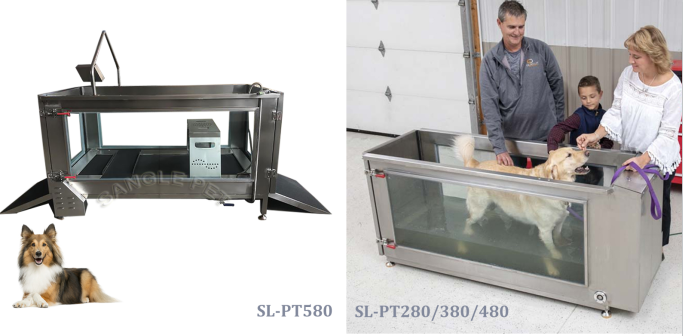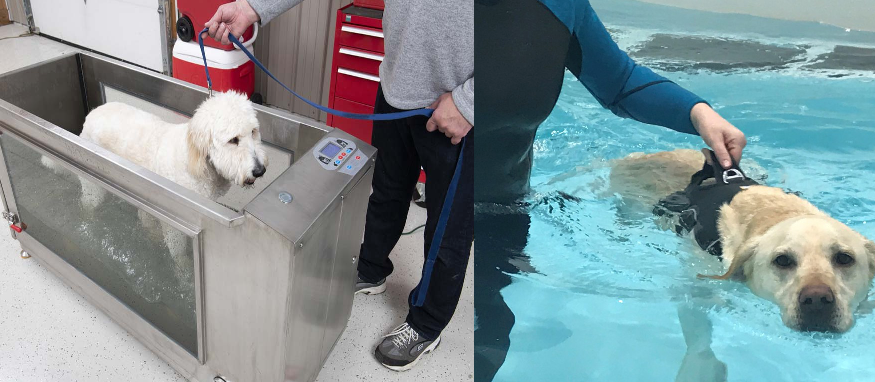Difference between Underwater Treadmill and Hydrotherapy Pool?
Difference between Underwater Treadmill and Hydrotherapy Pool?
About Canine Underwater Treadmill
A water treadmill is a little like the treadmills that you find in the gym – it has a moving belt to walk on, but it is built into a water-tight tank instead of being open sided. Once the dog is comfortable going into the tank, we can seal the doors which allows us to gradually fill the tank with warm water. When the water reaches the required level, we can start the belt which starts the dog walking.
When a dog is in a water treadmill, we can alter the level of the water. On land, a dog is 100% weight bearing, but we can change this using the water treadmill. For example, if we popped a dog into the treadmill and filled the water up to the level of their elbows, that dog would only be 85% weight bearing – so we’ve reduced the weight bearing by 15%. If we carried on filling the treadmill up to the top of the dog’s shoulder, he’d only be 38% weight bearing, so his weight bearing is reduced by a whopping 62%! This does come with some consequences, such as the fact it’s a bit harder doing a workout in deep water (anyone who has ever done aqua-aerobics will be able to confirm that!) so we have to balance out the level of difficulty with the reduction in weight bearing for the dog. But we love having that level of control!
Sangle has standard and multifuctional underwater treadmill available for choice. Our standard cheaper underwater treadmill could meet basic needs of hydrotehrapy for pets with one door side,no standing palce for professional therapist,but Sangle multifunctional water treadmill designed with that for commerical use.

Some advantages of the UWTM are:
· The aforementioned control! This allows us to perfectly place pooches for optimum rehab.
· The UWTM can be a little less intimidating than a pool full of water for dogs that are a little worried about getting wet.
· UWTM work can be really useful for pets with multiple conditions that need specific rehab. For example, sometimes patients will have orthopaedic surgery but will also have some muscle loss which requires rehabilitation from the operation and improvement of muscle bulk.
· The limbs can often extend more in a treadmill than they can in a pool. Patients that have conditions that make limb extension difficult, for example hip dysplasia, can do great things in the treadmill.
· We can control the walking or trotting speed of the treadmill, which stops the keen ones rushing too much or helps to keep those lazy-bones moving.
· The improvements in the movements (some accidental poetry there….) can very quickly be seen to transfer over to the animal’s movements on land, which often gives really impressive results within a really great
· Sometimes, a treadmill can be a suitable place to start for early rehab – there are some patients that can get going on the treadmill before they are ready for the pool. This includes some orthopedic patients, such as those that have had cruciate surgery.
How about the advantages of pool?
· Whilst the treadmill is amazing for limb extension, the pool is amazing for joint flexion. So depending on what we are trying to achieve, we can pick which one we use. For patients that are experiencing reduced flexion of their joints – perhaps from injury or surgery – the pool is perfect.
· Pools are fantastic for building core strength. The swimmers among you will know that swimming is hard work and requires a strong core – the more you swim, the stronger those abs get.
· Remember what we were saying about reduction in weight bearing with the treadmill? Well – in a pool, weight bearing is reduced by 100%! That’s right – floating in water is completely weightless (Here’s some trivia….that’s why it’s often used for training astronauts). Being totally weightless removes all the forces through the joints which is really useful for some patients, especially those for whom weight-bearing is painful at that point.
· Neurological patients are often physically unable to bear any weight of their own, and sometimes working in a weightless environment can help them regain some limb function, therefore setting them on the road to weight bearing on land again.
· Swimming is excellent for cardio fitness, making it excellent not just for patients needing to lose weight or rehabilitate from an injury, but also perfect for sporting or working dogs wanting to improve or maintain fitness.
· Dogs swim using the classic doggy-paddle. This works the front limbs very hard and can be excellent for building muscle in this area, for example – patients that need to strengthen following an injury. The flip side of this, is that the back legs work less hard….but that’s where the treadmill comes in!
Canine hydrotherapy pool is similar to a human swimming pool, but there are a few key differences. The areas all around the pool shold be extra grippy and safe, to encourage dogs to be confident. The entry and exit routes needs to be designed well to make sure that dogs can enter the water in a controlled manner, and of course, the water temperature and depth are just perfect. The harnesses and buoyancy jackets could be used to help maintain safety, especially in more vulnerable patients.
Whether to work your dog (or indeed your cat!) in the pool, or on the treadmill, it’s the water that’s doing the work here and the warm water is helpful for following benefits:
· Improving circulation
· Increasing calorie expenditure (meaning it’s great for weight loss)
· Improving nerve efficiency
· Improving coordination
· Improving and increasing soft-tissue elasticity
It’s worth remembering that not all dogs like to launch themselves enthusiastically into water.. For some dogs, water can be a little intimidating, and Dogs have to be ensured that they are super comfortable in the pool or the treadmill.
More details pls feel free to contact us freely by email at [email protected] or [email protected].
【 Go Back 】 | 【 Close this window 】




